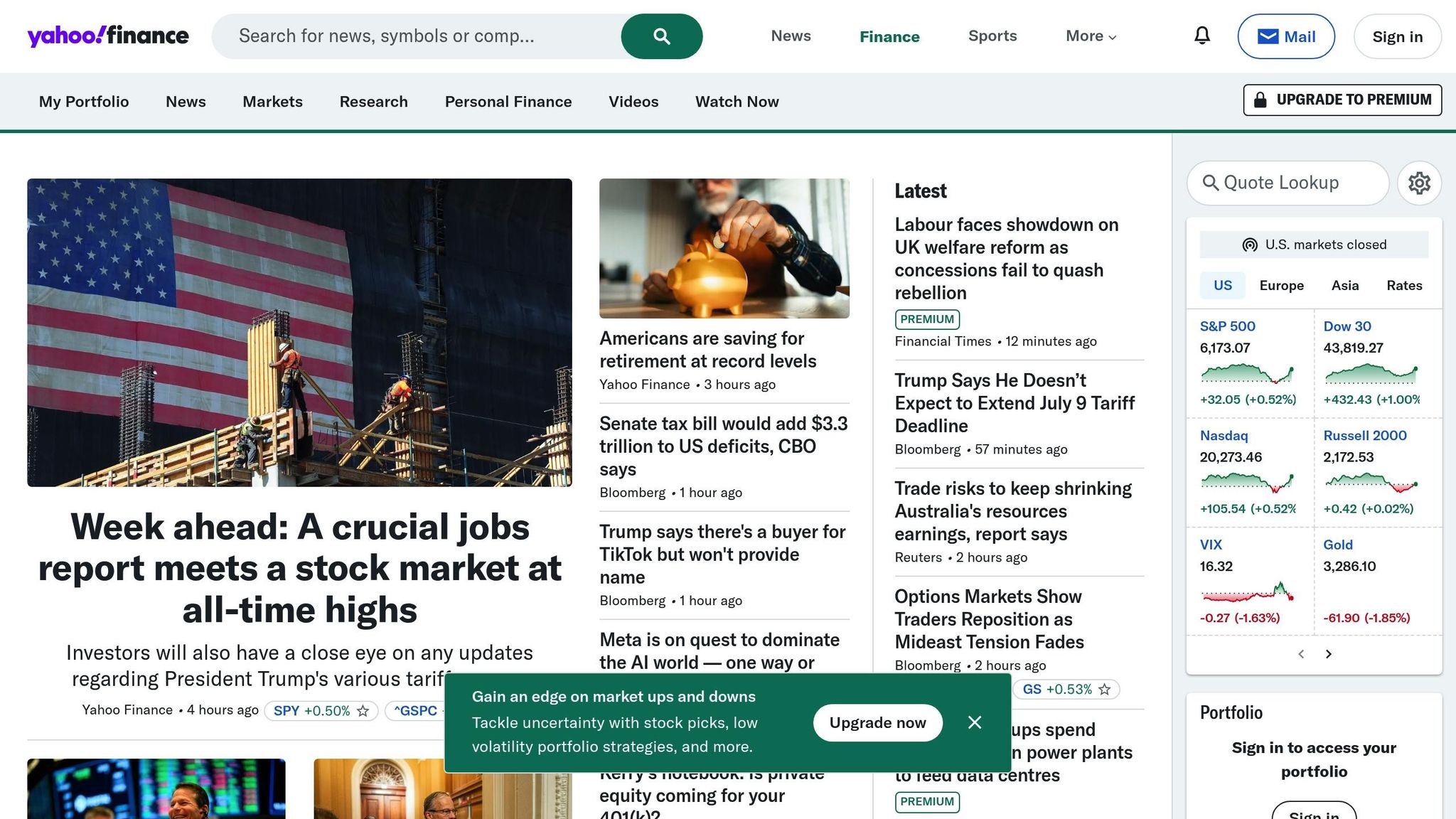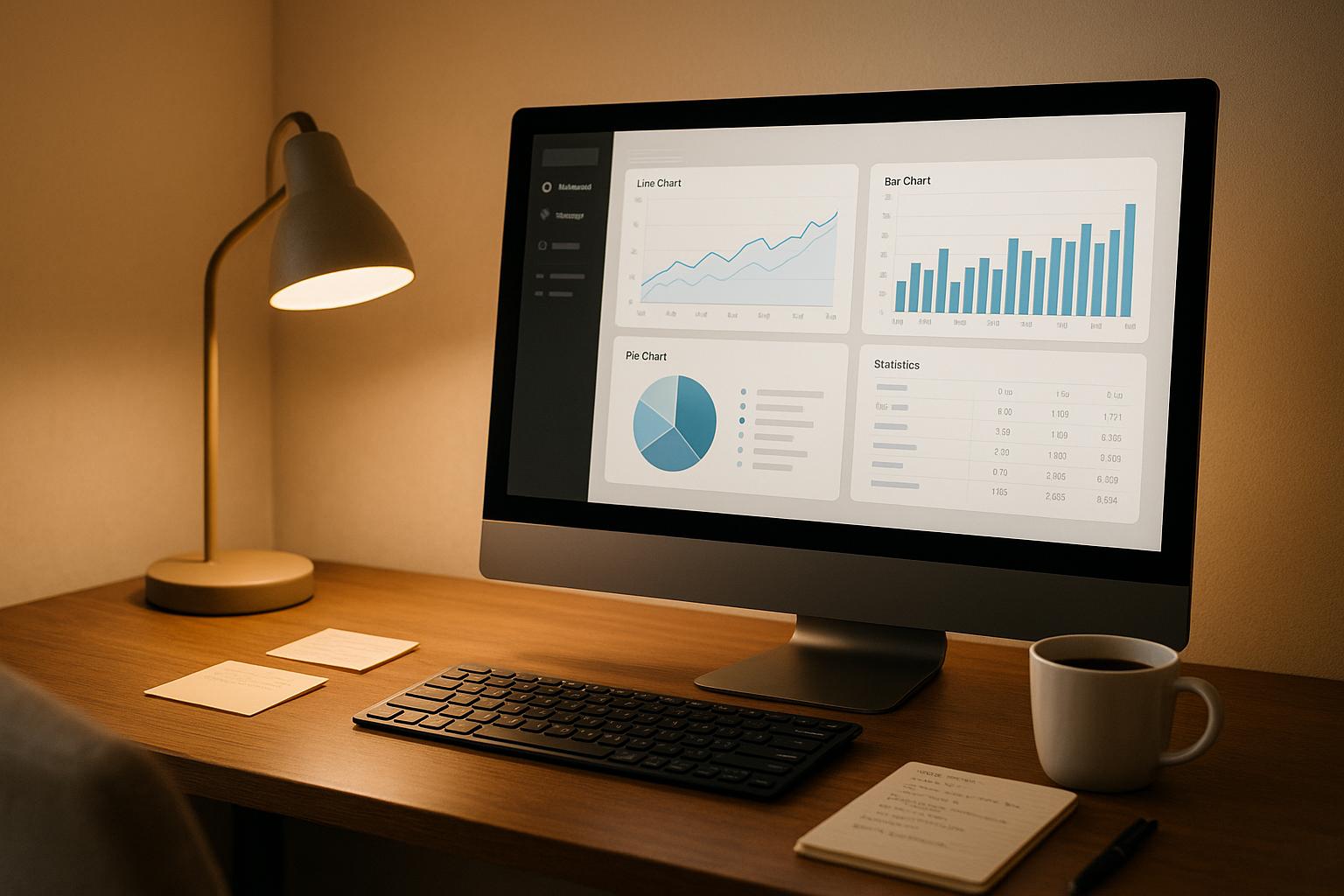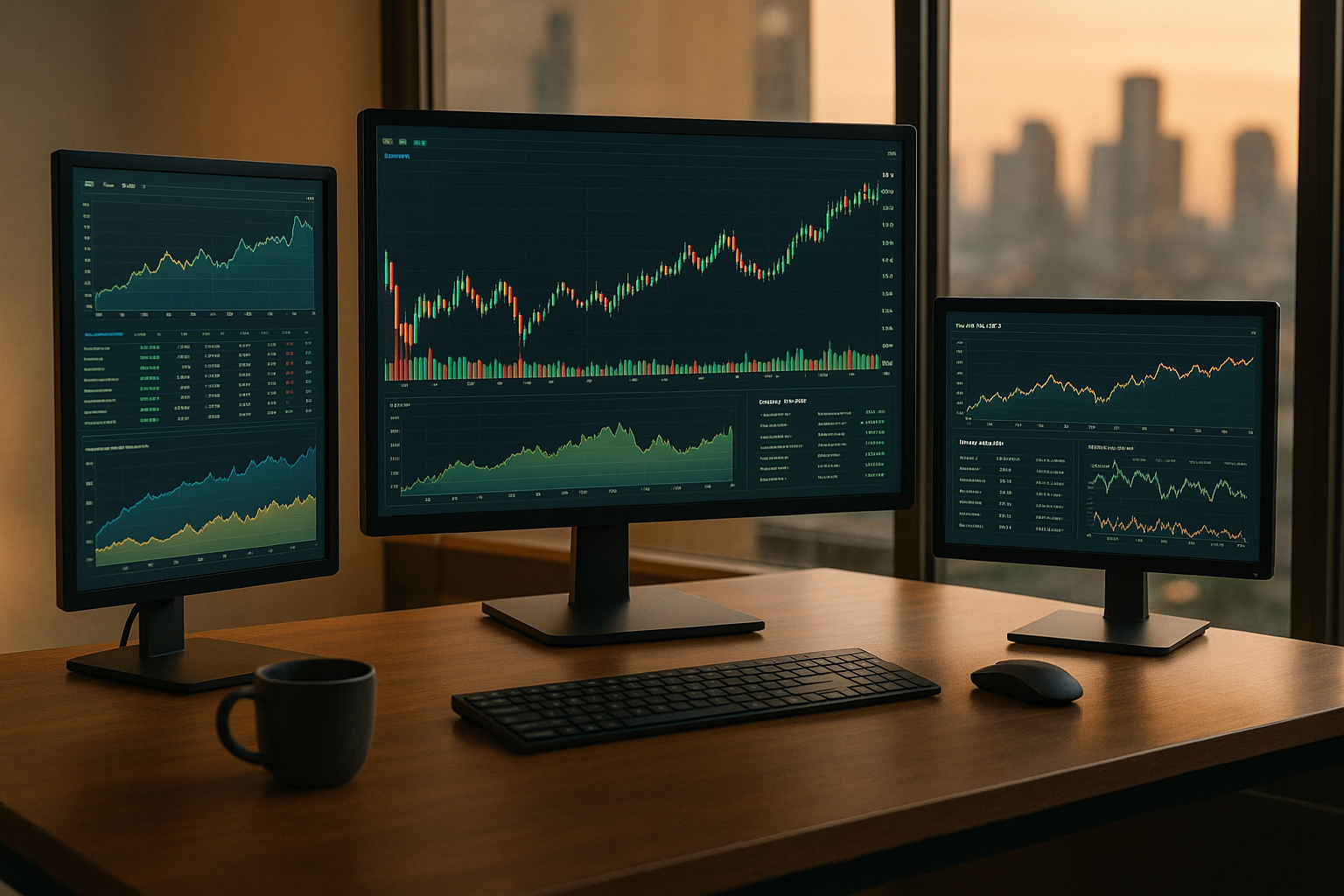Choosing the right stock screener depends on your goals, budget, and experience level. Free tools are great for beginners exploring the stock market, while paid screeners offer advanced features for experienced investors. Here's a quick breakdown:
- Free Stock Screeners: Ideal for beginners and casual investors. They cost nothing, provide basic filters like P/E ratios or dividend yield, and are easy to use. Downsides include delayed data, limited customization, and ads.
- Paid Stock Screeners: Suited for active traders and those with specific strategies. They offer real-time data, advanced filters, and tools like alerts and charting. Costs range from $7.99 to $299/month depending on features.
Key takeaway: Start with a free screener to learn and experiment. Upgrade to a paid version if you need real-time data, advanced analytics, or more control over your investment strategy.
Quick Comparison Table
| Feature | Free Stock Screeners | Paid Stock Screeners |
|---|---|---|
| Cost | $0/month | $7.99–$299/month |
| Data Updates | Delayed (15–20 mins) | Real-time |
| Filters | Basic (10–20 options) | Advanced (100+ options) |
| Customization | Minimal | Extensive |
| Ads | Present | None |
| Best For | Beginners, casual users | Experienced, active traders |
Start simple, then upgrade as your needs grow.
7 Best Stock Screeners in 2024 [It's Not Yahoo! Finance]

Free Stock Screeners: Features and Limits
Free stock screeners provide an accessible starting point for anyone looking to dip their toes into investment screening. They don't require any financial commitment, making them a great option for beginners.
Benefits of Free Stock Screeners
The biggest perk of free stock screeners? They're completely free. You can explore investment opportunities without worrying about subscription fees or trial periods. They also cover the essential metrics needed for basic stock analysis, helping you narrow down options that align with your investment goals.
"A stock screener is a powerful tool used by investors and traders to filter stocks based on predefined criteria", says the Bajaj Broking Team.
Many free platforms are designed with user-friendly interfaces, making navigation straightforward. This simplicity allows you to quickly grasp how filters work and see their effects on your search results. Plus, you can experiment with different screening strategies, learn from mistakes, and gain confidence - all without spending a dime.
But while these tools are great for getting started, they do come with some limitations.
Limits of Free Stock Screeners
Free stock screeners often lack the depth and flexibility of their paid counterparts. For instance:
- Limited filtering options: You might not have access to advanced metrics, restricting the depth of your analysis.
- Data delays: Free tools may not provide real-time data, which can be a drawback in fast-moving markets.
- Advertisements and sponsored content: These can be distracting and may slow down your workflow.
- Lack of customization: Most free screeners don't let you save your preferred filters or create personalized watchlists.
- Minimal customer support: You're usually left to rely on help documentation instead of getting direct assistance.
These limitations can be manageable at first, but as your investment strategy becomes more sophisticated, you might find yourself needing a paid tool.
When to Use Free Stock Screeners
Free stock screeners are perfect for beginners and casual investors. If you're just starting out, they offer a risk-free way to explore and refine your investment strategy. They're also a good fit if you're building a long-term portfolio and don't need real-time data or advanced features for frequent trading.
One of the best uses of free screeners is for learning and experimentation. They let you test out different strategies and get a feel for how the tools work before committing to a paid version. For example, you can use a free screener to identify banking sector stocks with low P/E ratios, high return on equity, and strong dividend yields. However, it's essential to validate these findings with additional research and market analysis.
If you find that the limitations of free tools are holding you back - whether it's the lack of real-time data or the inability to customize your searches - it might be time to consider upgrading to a paid screener that better meets your needs.
Paid Stock Screeners: Features and Benefits
When free tools no longer meet your needs, paid stock screeners step in with advanced features designed for serious investors. The next step? Evaluating pricing models to find a plan that aligns with your investment goals.
What Paid Stock Screeners Offer
Paid stock screeners provide real-time data, an essential feature for active traders who can't afford the delays often found in free versions.
What sets paid tools apart is their advanced filtering options. These include technical filters, custom formulas, and calculated fields, letting you tailor your search to match your specific investment strategy. Active traders gain access to technical indicators like moving averages, Beta, volatility measures, and detailed performance metrics, offering precise control when navigating the roughly 3,500 companies listed on U.S. stock exchanges.
Another advantage? Paid platforms let you save filters and set up weekly alerts. This level of automation saves time and ensures you don't miss out on potential opportunities.
Additionally, these tools remove the clutter of advertisements and deliver better data visualization through advanced charting tools and customizable dashboards. This makes analyzing stocks easier and more intuitive.
Pricing and Subscription Models
The cost of paid stock screeners depends on the features offered and the intended user base. Here's a breakdown:
Budget-Friendly Options:
- FINVIZ Elite: $24.96/month, offering real-time data and advanced features.
- Stock Rover: Plans range from $7.99 to $27.99/month, with a focus on fundamental analysis.
- TC2000: Tiered subscriptions from $9.99 to $59.99/month.
Mid-Range Platforms:
- TradingView: $12.95 to $49.95/month, covering global markets.
- ChartMill: $34.97/month or $299.97/year.
Premium Solutions:
- Trade Ideas: $89 to $178/month, featuring AI-powered scanning.
- Benzinga Pro: $37 to $197/month, offering real-time news and data.
- ZACKS: Premium plans range from $249 to $299/year, with some options costing up to $299/month.
Many platforms provide annual payment discounts, often saving 10-20% compared to monthly billing. Free trials or basic versions are also common, giving you a chance to test the platform before committing.
Who Benefits from Paid Stock Screeners?
Paid stock screeners are ideal for active traders who rely on real-time data and advanced technical analysis tools. The speed and accuracy of these tools can directly influence trading outcomes, making the subscription cost a worthwhile investment.
Investors with specific strategies also find value in these platforms. Whether you're focused on fundamental analysis, technical patterns, or quantitative methods, paid screeners offer the depth and flexibility needed for more complex strategies.
For seasoned investors and analysts, the appeal lies in advanced analytical tools and AI-driven insights. For instance, Trade Ideas' AI engine, "Holly", evaluates thousands of stocks across hundreds of technical and fundamental criteria to pinpoint high-probability trade ideas. Similarly, Stock Rover provides access to over 650 metrics, making it a powerhouse for those focused on fundamental analysis.
If your investment approach requires detailed analytics, backtesting capabilities, or customizable alerts, a paid screener can be a game-changer. These tools are particularly useful as your investment strategies evolve and you need to streamline your research and trading processes.
For beginners, it's best to start with simpler tools and gradually explore more advanced features. When you're ready to move beyond free platforms, a paid screener can significantly enhance your research and decision-making capabilities. It's a natural next step in growing as an investor.
sbb-itb-2e26d5a
Free vs. Paid Stock Screeners Comparison
Understanding the differences between free and paid stock screeners can help you make more informed investment decisions. Below is a detailed comparison of the key features offered by each type.
Feature and Cost Comparison Table
| Feature | Free Stock Screeners | Paid Stock Screeners |
|---|---|---|
| Cost | $0/month | $7.99 – $299/month |
| Data Updates | Delayed (15–20 minutes) | Real-time |
| Number of Filters | Basic (around 10–20 criteria) | Advanced (often 100+ criteria) |
| Technical Indicators | Limited selection | Comprehensive suite |
| Customization | Minimal | Extensive |
| Advertisements | Present | Ad-free experience |
| Customer Support | Limited or none | Dedicated support |
| Saved Searches | Few or none | Unlimited |
| Alerts & Notifications | Basic | Advanced automation |
| Export Options | Limited | Full data export |
| Best For | Casual investors, beginners | Active traders, serious investors |
For those just starting out, free stock screeners are an excellent way to dip your toes into the stock market without spending any money. They provide a simple, accessible way to explore and learn. However, as you gain experience, you might find their limited features and delayed data frustrating, especially if you're looking to build more complex strategies.
Paid stock screeners, on the other hand, are designed to meet the needs of more serious investors. Along with advanced features, they often offer broader market coverage. For example, platforms like TradingView provide access to over 150 international exchanges in more than 50 countries, helping investors diversify their portfolios.
An analysis by Investopedia, which evaluated 16 stock screeners based on 17 criteria, revealed that paid platforms consistently deliver better data accuracy, deeper features, and a smoother user experience. This demonstrates why many investors eventually transition to paid tools as their strategies and requirements become more sophisticated.
If you're curious about premium features but hesitant to commit, many platforms offer free trials or limited basic versions. These allow you to explore the benefits of paid tools before deciding if they're worth the investment. Starting with free tools and upgrading as your needs evolve is a common path for many investors.
How Beginners Should Choose a Stock Screener
Choosing your first stock screener is all about understanding your current needs and anticipating how they might change as you grow as an investor.
What to Consider Before Choosing
When picking a stock screener, think about your investment goals, budget, and data requirements. For instance, value investors might focus on filters like price-to-earnings ratios and debt levels, while growth investors might prioritize revenue and earnings momentum.
Your budget plays a big role. If you’re a casual investor who only checks stocks occasionally, free screeners might be enough. But if stock screening becomes a key part of your strategy, a paid platform could offer advanced tools and real-time data that free versions can’t match.
Next, assess your data needs. Do you need real-time stock prices, or is a slight delay (like 15–20 minutes) acceptable? Long-term investors might be fine with delayed data, but active traders often benefit from real-time updates.
Another factor is how comfortable you are with technical tools. Beginners might prefer a simple interface with basic filters, while others may want to dive into advanced features, like technical indicators. If you're new to these platforms, look for one with strong customer support to help you get started.
Lastly, your investment style should guide your choice. Whether you’re focused on value, growth, or dividend income, make sure the screener you pick offers the right tools. For example, look for fundamental metrics if you’re a value investor, revenue and earnings filters for growth strategies, or yield and payout ratio options if dividends are your priority.
It’s worth noting that your needs might evolve over time. Starting with a free screener lets you learn the basics, and you can upgrade later as your strategy becomes more refined.
Start Free, Then Upgrade Later
For beginners, starting with a free screener is a smart way to learn the ropes. Once you’re comfortable, you can explore premium options to access advanced features.
Take advantage of free trials to test premium tools before committing to a paid plan. During this time, refine your screening parameters based on your strategy. For example, if dividend stocks are your focus, look for tools with strong income-oriented filters. If you’re targeting growth stocks, prioritize features that highlight earnings and revenue trends.
Experiment with screening different types of stocks - such as large-cap versus small-cap, domestic versus international, or growth versus value. This hands-on approach helps you understand what works best for you. If you start to feel limited by a free screener - like being unable to save searches, access real-time data, or use advanced indicators - it may be time to upgrade.
For more in-depth comparisons, check out the Best Investing Tools Directory. It offers detailed reviews to help you find a screener that aligns with your evolving investment strategy.
Conclusion
Select a stock screener that aligns with your current level of experience and investment needs. For beginners, free tools like Finviz - which offers over 60 filters in its free version - are a great way to get started without any financial commitment. That said, free screeners often come with trade-offs, such as delayed data and limited customization options.
On the other hand, paid screeners provide access to real-time data, advanced filters, and more in-depth analysis tools. While these features can be incredibly useful, they might feel overwhelming if you're just starting out. Starting with a free tool allows you to build confidence and skills without investing in features you may not yet need.
Ultimately, your choice should reflect both your immediate needs and your goals for long-term growth as an investor.
Choosing the Right Screener for You
When deciding on a stock screener, think about how your investment goals and available time shape your needs. Your goals should guide your choice more than flashy features or marketing claims. For example, value investors might benefit from basic fundamental filters, while growth-focused investors may eventually need tools for analyzing revenue and earnings trends.
If you're a casual investor, free screeners with delayed data might be more than enough. However, if screening becomes a critical part of your strategy, the real-time data and advanced capabilities of paid platforms could provide a significant edge.
As you gain more experience and refine your investment approach, your screening requirements will naturally evolve. Starting with simple tools and upgrading when necessary ensures that your screener always matches your skill level and investment objectives.
FAQs
What should beginners know about the differences between free and paid stock screeners?
Free and paid stock screeners primarily differ in the range of features, data access, and tools they provide.
Free stock screeners are a solid starting point for beginners. They offer basic filtering options and limited access to real-time data, making them a no-cost way to dip your toes into investing. That said, their functionality is often limited, lacking the advanced analytics and tools that more seasoned investors might need.
Paid stock screeners, on the flip side, are designed for those who require more robust capabilities. These typically include advanced filtering options, comprehensive real-time data, detailed analytics, and extra tools to support thorough research and active trading. Whether you choose a free or paid option largely depends on your investment goals and how much detail you need to make well-informed decisions.
When should a beginner switch from a free stock screener to a paid one?
As a beginner, starting with free stock screeners is a smart move. They’re perfect for grasping the basics and shaping your investment strategies without spending a dime. However, as you gain experience, you might run into some limitations - like fewer filters, less detailed data, or restricted access to advanced features.
When your research becomes more sophisticated - think in-depth analysis, real-time data, or highly specific screening options - it might be time to consider a paid stock screener. The key is to weigh the value of the extra features against your investment goals and budget. Paid tools can be especially useful if they save you time or provide insights that make your decision-making process more effective.
How can beginners make the most of free stock screeners despite their limitations?
To make the most of free stock screeners, start by clearly defining your investment goals. Think about what you're aiming for - whether it's long-term growth, dividend income, or something else - and set up specific screening criteria that align with those objectives. This step helps you narrow down the list of stocks to those that truly fit your needs.
Once you’ve got a list of potential picks, dig deeper. Free screeners often lack some of the more advanced data and metrics, so it’s important to analyze each stock further on your own. If the screener offers historical data, try testing your criteria against past market conditions to see how they might perform.
As you gain experience and market trends shift, don’t hesitate to tweak your filters. While free tools have their limits, a thoughtful and consistent strategy can still uncover useful insights, especially for those just starting out.



